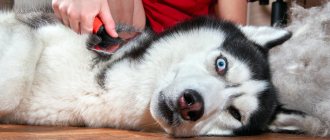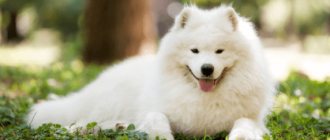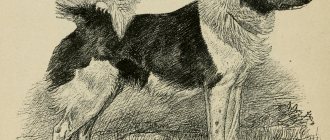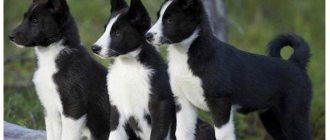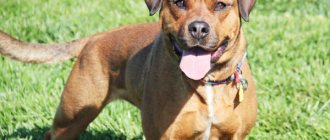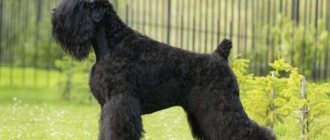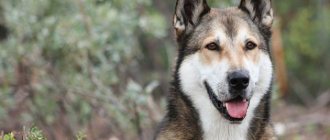In different breeds and dogs living in different conditions, the shedding process occurs differently. Dogs living in nature shed their fur “on a schedule”: before winter, in order to prepare for frost and build up a warm undercoat and long hair, and before summer, to replace the warm coat with thinner hair.
For dogs that live at home, where they are not afraid of any frost or heat, shedding can drag on for the entire season. This is why a dog can shed even in winter.
There are several types of shedding:
- seasonal - the process of shedding hair occurs twice a year: in the spring shorter hair grows, and in the fall the hair becomes thicker and longer;
- age-related - usually goes away at one month or six months of age, often with a change in fur, the color also changes;
- permanent - usually occurs in dogs kept at home. Due to the stable temperature of the room, the biological rhythms of the animal are disrupted, and the dog sheds constantly.
What to do if your dog sheds a lot?
To make life easier for a dog that sheds, you need to brush it every day with a special brush. This will remove lost hair and new hair will begin to grow faster. In addition, brushing will have a beneficial effect on the blood circulation of the skin, which will strengthen the fresh coat. The more often you groom your dog, the less hair will remain on the carpets and sofa.
If your dog's hair is not falling out for natural reasons, you should definitely reconsider its diet. Perhaps she lacks some vitamins and minerals, which is why the hair follicles have weakened and the hair has begun to fall out.
A bad sign is when a dog’s fur sheds in places, and ulcers or sores form in these places. In this case, you need to contact a veterinarian, because these may be symptoms of various diseases.
How long does it take for dogs to shed?
Seasonal shedding with proper care for the dog lasts 1-2 weeks. Shedding can be permanent all year round, but you can reduce its intensity. Brush your pet more often and make sure that its diet always contains all the necessary vitamins and substances that affect the quality of its coat.
Are there dogs that don't shed?
There are no dogs that do not shed at all, but some breeds shed much less than others, for example:
All dogs, regardless of breed, shed. But there are breeds that do not shed profusely.
These breeds include Irish Water Spaniel, Spanish Water Dog, Giant Schnauzer, Black Russian Terrier, Bichon Frize, Chinese Crested, Yorkshire Terrier, Mexican Hairless, Poodle, Shih Tzu, Miniature Schnauzer, Dandie Dinmont Terrier, Bedlington Terrier, Tibetan Terrier , Maltese, Havanese Bichon, Coton de Tulear.
Causes of shedding in dogs
Seasonal shedding in dogs is a natural process, but hair loss can also occur for other reasons.
One of the reasons is dehydration, i.e. lack of access to water and lack of water in food leads to dry skin, as a result of which there is excessive shedding, and in some cases dehydration leads to the development of diseases.
As a result of poor nutrition or illness, the body does not receive the nutrients necessary for healthy coat and skin, the condition of the skin and coat worsens, and hair begins to fall out.
It is known that bitches begin to shed before going into heat. Therefore, this factor should also be taken into account if off-season molting suddenly begins. Age-related shedding and shedding in bitches who have stopped nursing puppies are considered normal.
Hair loss can be triggered by stress, for example, during pregnancy, moving, or surgery.
Excessive shedding can occur in pets living in an apartment where the air temperature is high. Due to the heat, hair may begin to fall out regardless of the change of season. The optimal maximum indoor air temperature should not exceed +26 degrees.
Why does my terrier's hair fall out?
A dog's coat is divided into guard hair and a soft undercoat underneath, which together reliably protect the pet from various weather conditions. In addition to the undercoat and guard hair, toy terriers have vibrissae - whiskers and eyebrows that help the animal navigate in space.
If the pet begins to actively lose hair, the owner, first of all, needs to contact a veterinarian to determine the reason why the terrier’s hair is falling out.
The reasons for hair loss in a toy terrier can be very diverse:
- Seasonal shedding. Normally, toy terriers shed twice – in spring and autumn. However, often animals kept in an apartment begin to shed year-round - the room is always maintained at a warm temperature, and pets cease to distinguish what time of year it is outside;
- Wrong diet. Often a terrier's hair falls out due to unbalanced feeding - a pet can go bald both due to a deficiency of vitamins and from their excess. In this case, it is necessary to immediately establish proper feeding of the toy terrier - the animal must receive a sufficient amount of animal protein, vitamins and minerals; you can learn more about feeding your pet here;
- Allergic reaction. Anything can cause a malfunction of the immune system - food, cosmetics, medicines, plants, a collar and low-quality toys. In this case, you can act by elimination - first of all, you need to give up new cosmetics, toys or food recently introduced into the diet. If there have been no innovations, it is worth excluding strong allergens from natural feeding - red vegetables and fruits, chicken meat and eggs. It is also worth contacting a veterinarian who will help identify the allergen and prescribe antihistamines. In case of allergies, in addition to hair loss, the animal will be bothered by itching and rashes on the skin, in the form of red pimples;
- Hormonal imbalance in the body of a toy terrier. Failures can be caused by medications, dysfunction of the thyroid gland or adrenal glands. To identify hormonal imbalance, you need to take a biochemical blood test, as well as blood for hormones, a biopsy and a skin scraping;
- Parasites (worms and fleas). At the same time, hair loss can also be caused by uncontrolled use of antiparasitic drugs, since these drugs contain poison, even despite small doses, they should not be given to your pet just like that;
- Improper care of your pet's fur. Excessive bathing of a Toy Terrier can cause irritation, dandruff and itching, causing the pet to scratch the skin excessively and hair to begin to fall out. Therefore, when purchasing a puppy, you should carefully consider the advice and recommendations of the breeder; details of caring for the puppy can be found here;
- Severe stress. That terrier, experiencing separation from its owner, sitting in the apartment all day or for other reasons, may experience stress, due to which the terrier’s hair begins to fall out;
- Skin infections. Ringworm, demadecosis, microsporia and other diseases cause itching and hair loss;
- Childbirth. A toy terrier bitch may begin to shed after giving birth.
When does shedding begin in dogs?
The very first coat changes by 1.5 months, and in some breeds the color of the coat also changes, becoming darker or, conversely, lighter.
The first age-related shedding in dogs begins no earlier than 6 months of age, during which the downy coat changes to a harder and denser one. In some pets, the fur takes several years to develop and becomes characteristic of adult animals only after several molts.
However, in some cases, the first age-related shedding in dogs can begin at 3.5-4 months, when the guard hair begins to grow. The process of hair change can last up to a year, and in some breeds up to 2 years.
Shedding time in dogs
Some breeds have a long and heavy shedding period, while other dogs shed all year round, shedding small amounts of hair daily. Typically, pets shed twice a year:
- in the fall
, usually in September, the light summer coat is shed and a thick, warm undercoat is built up, the pet visually increases in volume, becomes softer and fluffier; - at the end of spring
, usually in May, the undercoat falls out. Spring shedding in dogs lasts less time than autumn shedding.
The timing of shedding in dogs varies, with seasonal shedding lasting about 1-3 weeks. For pets living in an apartment, the timing of shedding may change, and instead of a seasonal change, hair loss occurs all year round due to constant air temperature. In heated and artificially lit houses, the animal’s brain does not receive a signal that a coat change is required; the pets’ bodies are not exposed to natural temperatures, especially if the animals spend most of their time in the apartment and walk very little. The body does not notice the change of seasons and an abundant period of molting does not occur. As a result, shedding occurs on a constant basis every day in small quantities.
The dog's hair is falling out, going bald, and bald spots appear.
Most dog owners know that if their pet's fur begins to actively fall out several times a year, there is no need to worry - this is a process of seasonal shedding. However, if this period is still far away, and the fur begins to become thin and actively fall out, the owners of the animal should be actively concerned about its health. It is also worth remembering that seasonal shedding does not in any way affect the general well-being of the dog, while hair loss or baldness, also known as alopecia, caused by illness or serious disorders of the body, can provoke other clinical signs, including, for example, lethargy , lack of appetite.
We recommend reading: Childbirth of a Fold Cat, Medicines to Help
How to get rid of shedding
It is impossible to completely stop the process of hair loss, but regular care during seasonal shedding in dogs will help stop the uncontrolled spread of hair around the house.
An effective hair removal tool is the furminator, the use of which can remove most dead hair in just one session, although the session can last up to an hour or more, depending on the size of the animal and the thickness of the undercoat.
To remove undercoat, you can use brushes, slicker brushes, rubber mittens, and other tools designed for this purpose, but it is not recommended to cut your pets' hair. After cutting, the undercoat will grow even thicker.
To speed up shedding, it is effective to wash your pet in warm water with protein shampoo or shampoo for shedding dogs, then wrap your pet in a warm blanket for 1-2 hours. It is important to monitor the animal's condition during this time, otherwise there is a risk of overheating. This method allows you to speed up shedding, which will take several days, but will be accompanied by heavy hair loss. However, washing the animal is often not recommended.
To reduce shedding in a dog, you need to feed your pet properly. A balanced diet is important, the basis of which should be meat, regardless of the type of feeding. Dry food and a natural diet should contain high-quality products rich in nutrients (vitamins, Omega-3 and Omega-6 fatty acids, antioxidants), which are necessary to maintain the health of the coat and skin, and the body as a whole. With natural feeding, it is useful to give the animal vitamins, but if the pet eats dry high-quality food, there is no need for additional vitamins.
The animal should have free access to water; it is recommended to include wet foods in the diet, such as low-fat kefir and yogurt. Wet commercial food contains up to 78% moisture, and dry food contains only 10%, so it is recommended to feed your pet not only dry, but also wet food.
To prevent fur from spreading around the house, dog owners wear Lycra pet suits. Lycra clothing is lightweight, ventilated and comfortable.
In the article I will look at the reasons why a dog begins to shed heavily, what to do, as well as ways to prevent it. I'll tell you how much shedding happens. I will list options for eliminating unpleasant odor from a dog, and also tell you how to properly care for the animal, whether it needs to be washed, how to rid the animal of shedding and remove dog fluff.
Animal fur is short-lived.
In winter, the animal needs a warm coat, which is not necessary in summer, this is provided by nature. Due to the fact that one coat is replaced by another, the four-legged friend sheds, getting rid of excess hair and fluff in the summer.
A pet is in almost the same temperature conditions all year round. Because of this, the dog sheds regardless of the time of year. Wool constantly flies all over the apartment and can stink.
Wool has one property - it undergoes renewal 2 times a year.
In addition to seasonal shedding: in autumn and spring, pets can also experience out-of-season molts.
The frequency of hair loss can be influenced by your dog's health problems. If your pet is shedding very heavily, you should make an appointment with a specialist.
But we must not forget that you can help your four-legged friend at home.
Requirements for care and maintenance
The Russian Toy Terrier, which is easy to care for, will become a wonderful member of your family. It only needs to be bathed a few times a year.
Once a month, trim your pet’s nails, comb its fur, and sometimes give it bones to brush its teeth.
Toys that participate in various exhibitions require more care. After vaccination, it is forbidden to bathe your friend for two weeks.
Ways to Prevent Shedding in Dogs
Shedding is a natural process and it is impossible to completely get rid of it.
Combing
The simplest and most effective way to get rid of excess hair is to regularly brush your pet. This is best done with a special brush or furminator. Combing is also necessary to prevent the formation of tangles.
The main method for shedding is to comb the fur daily with a special comb.
For breeds with not very large undercoat, in addition to a brush, you can use special gloves that will get rid of excess hair and remove dead hairs.
You should not shave your dog to prevent shedding, since in the summer the coat protects the pet from exposure to direct sunlight and overheating.
Worming
Worms weaken the pet's immunity and destroy its body from the inside, so the pet's skin becomes duller and thinner, and hair falls out. An important way to prevent hair loss in your pet is deworming. This event should be carried out depending on the condition and well-being of the dog.
Veterinarians recommend treating for worms every 3 months as a preventative measure.
Taking vitamins
All pet owners need to know that with severe hair loss, the pet’s body often lacks B vitamins and minerals, since their content in food is very small. To solve this problem, you should introduce special vitamins into your four-legged pet’s diet.
Only a veterinarian can help you decide on the choice of supplement, so if you have problems with your fur, you should immediately contact him for help.
In veterinary pharmacies you can purchase special preparations that improve coat quality.
Proper care
Proper animal care plays a very important role and directly reflects the appearance and condition of the animal's coat. To prevent your four-legged friend from shedding, you need to monitor his health and well-being. The animal should be fed exclusively with natural products that do not contain allergens.
There is no need to overuse dry food, as this negatively affects the health of the pet.
To ensure shine, silkiness and smoothness of the coat, you should bathe the animal regularly and do not forget that care products must be of high quality and contain only natural ingredients.
Causes of severe hair loss in dogs
Possible causes of excessive shedding in a pet include the following:
- the presence of fleas and/or ticks on the body;
- various fungal or bacterial infections;
- allergy in an animal;
- side effects of medications;
- period of pregnancy and lactation;
- diseases of the kidneys, liver, thyroid gland and adrenal glands;
- sunburn, etc.
The reason for severe shedding in a dog can be the person himself if he bathes his pet too often.
During the period of shedding, due to internal imbalance and various diseases, the animal may begin to smell like a dog.
Also, the appearance of odor can be caused by improper or insufficient care of the animal.
Possible causes of hair loss in dogs
There are many factors that can provoke active hair loss in an animal. All of them can be divided into two large blocks: hormonal and non-hormonal.
In order to determine the first causes, dog owners should take a closer look at the bald areas: if hair falls out on symmetrical areas of the body, the cause of hair loss most likely lies in hormonal disorders. But if the affected areas with missing hair are located chaotically, the cause of the pathology is absolutely not related to hormones.
Hormonal diseases that can cause baldness include:
- Cushing's syndrome, also known as hyperadrenocorticism. This disease causes severe hair loss throughout the pet's body. This reaction of the body to this disease is explained by an excess of one of the hormones – cortisol. In addition to severe hair loss, Cushing's syndrome is characterized by the presence of certain clinical signs, including sudden weight gain, constant thirst and, as a result, abnormally frequent urination, swelling and drooping of the dog's abdomen. In addition, some infections may recur. In some cases, Cushing's syndrome can be triggered by taking certain steroid drugs.
- Excess estrogen or hyperestrogenism. Contrary to the popular stereotype, this disease can occur in both females and males of different breeds. Hyperestrogenism is characterized by severe hair loss in the genital area, a sharp enlargement of the vulva in females and swelling of the foreskin in males. All these changes occur due to an imbalance of sex hormones.
- Lack of estrogen or hypoestrogenism. This disease is most often found in spayed female dogs who have already reached middle age. With hypoestrogenism, a dog's coat usually becomes very thin, first near the genitals, and then throughout the body, and the rate of hair growth is also greatly reduced. Against this background, it is noticeable that the female’s skin becomes very tender and soft.
- Impaired release of growth hormone into the body. This condition is usually accompanied by absolutely symmetrical hair loss in different parts of the body. Growth hormone deficiency is usually observed in males during puberty. There is a certain breed predisposition to this disorder: most often, dogs of the Chow Chow, Poodle, Boxer, Airedale Terrier, Pomeranian, and Dutch Wolf Spitz breeds suffer from it.
- Hypothyroidism is a disease whose characteristic symptom is an acute lack of thyroid hormones. In addition to hair loss and fragility, the presence of hypothyroidism can be determined by the following signs: lethargy, apathy of the animal, refusal of physical activity; sudden and “unreasonable” weight gain; low degree of protection against various infections.
Non-hormonal factors (various diseases and conditions of the body) that cause hair loss in dogs include:
- Seasonal and age-related molting. Similar dynamics in hair loss in pets are known to every dog owner. Typically, the extent of shedding in puppies directly depends on the type of hair coat, as well as the breed of the animal. Some breeds are characterized by very heavy shedding. One of the brightest representatives of such species is the orange - in the right period it loses a colossal amount of hair and becomes covered with light hairless spots. As adults, dogs shed several times a year. This is an absolutely normal phenomenon that should not cause any concern to pet owners. However, in order to avoid dermatological problems during this period, it is necessary to frequently clean and care for the animal’s skin. In females, molting can be observed not only in a certain season, but also during the sexual cycle and immediately after childbirth. However, the occurrence of molting is not always due to natural causes. In some cases, excessive hair loss can occur during very strong stress, for example, when moving, changing owners, or even visiting a veterinarian. Unplanned shedding in dogs can also be triggered by a certain cosmetic product that compassionate dog owners use too often when bathing.
- Food and non-food allergies. Dog owners think that various types of allergies are quite rare. However, it is not. An allergic reaction may well occur during experimentation with new food products - even a small amount of an ingredient that was not previously included in the animal’s menu can provoke the appearance of itching, rashes, and bald spots. Moreover, the pet’s body may react inadequately even to the food that it eats constantly. One of the consequences of allergies may be the appearance of allergic (atopic) dermatitis. In addition to food allergies, your dog may have an allergic reaction to certain components and substances from the environment, as well as cosmetics. Such allergies can also occur seasonally.
- Acanthosis nigricans. This disease is characterized by active hair loss in the armpits and ears of the pet. These areas of the animal's body become greasy and emit a pronounced unpleasant odor. There is a breed predisposition to this disease - mainly dachshunds suffer from acanthosis nigricans.
- Fleas, ticks, lice eaters and even helminths can also cause hair loss. Thus, scabies (demodectic mange and sarcoptic mange) are common. This disease is parasitic. Scabies is caused by mites. Middle-aged and young animals most often suffer from demodicosis. This is why puppies suffering from uncontrolled hair loss are usually tested for this disease. The main accompanying symptom of demodicosis is severe itching. Despite the fact that Demodex can live on a dog of any breed, most often Shar-Peis or Bull Terriers, as well as pets with significantly weakened immune systems, suffer from this parasite. As for the localization of the affected areas of the dermis, the most severe baldness with demodicosis is usually observed in the area of the dog’s lips and eyelids, on the hind limbs or on the stomach. Bald spots can reach several centimeters in diameter. If itching and hair loss are ignored for a long enough time, the number of affected areas can greatly increase, and the bald spots themselves can grow greatly in size.
- Yeast (fungal) infections are also common causes of hair loss in dogs, especially at a young age. The most dangerous is ringworm, which, in addition to causing many problems for dogs, can also spread to their owners. Basically, such infections affect areas with high humidity, such as armpits or skin folds. There is a certain breed predilection for this disease - sharpeis, bulldogs, and other dogs with many folds of skin on the body are most susceptible to it. Additional clinical signs of a yeast infection include increased oiliness of the skin and a repulsive odor emanating from the affected areas.
- Bacterial skin infections. The most common of these is pyoderma, which is caused by a decrease in the dog’s immunity.
- Solar dermatitis is characterized by the fact that baldness occurs mainly on the animal's face. Individuals with poorly pigmented skin on the nose are especially susceptible to this disease. Solar dermatitis is dangerous because, in addition to active hair loss, it can provoke skin ulceration and also lead to many autoimmune problems.
- Blue Doberman syndrome, also known as chromatic mutation alopecia. This disease causes severe hair loss throughout the pet's body. At the same time, it visually creates the impression that the dog has been “eaten” by a moth. During such alopecia, numerous pustules and papules form on the skin. Most often, it is Dobermans who suffer from the disease.
- Pronounced zinc deficiency. This disorder provokes increased hardness of the skin. In some cases, scales may form on the dermis, and cracking of the soft pads of the animal’s paws is also possible. Northern and Arctic dogs most often suffer from zinc deficiency.
- Vitiligo causes hair loss due to loss of pigment in the dermis. The most active hair loss can be observed on the animal's head. The breeds most susceptible to vitiligo are Belgian terriers and Rottweilers.
- Adenitis of the sebaceous glands is a disease, the main clinical sign of which is symmetrical baldness of the pet’s muzzle, head, back and neck. Most often, poodles suffer from adenitis. This disease can cause an infection of the hair follicles.
- Seborrhea, also known as dandruff, can simultaneously cause hair loss and may well be a secondary disease.
- Ringworm is an infectious disease caused by a fungus. During lichen, small bald areas covered with a crust appear on the animal's body.
We recommend reading: Childbirth of a Fold Cat, Medicines to Help
How to get rid of dog smell in an apartment
In order to get rid of an unpleasant odor, just follow these steps:
- wash the animal’s paws after each walk, and also bathe the animal approximately once a month (more often in summer);
- Clean your pet's ears regularly;
- carry out hygienic teeth cleaning;
- Make sure that the dog’s diet is balanced and that the diet is followed.
Regularly clean carpets, sofas and other textile surfaces from dog hair residues.
Human hygiene products are not suitable for caring for dogs, as they have different acidity.
You should only bathe your pet with dog shampoo.
Every owner should carefully monitor the well-being of their beloved pet and pay attention to its appearance. To ensure that your four-legged friend's fur always remains silky and he does not shed for no reason, you should properly care for him and feed him properly, and also regularly visit a veterinarian.
05/07/2017 by Evgeniy
There are a number of artificially bred breeds that are not subject to seasonal shedding. These dogs were specially selected by selective breeding and bred for people who are allergic to animal fur, but who dream of having a pet. These breeds include the Maltese, Tibetan terrier, Yorkshire terriers, poodles, and Irish spaniel. But when purchasing a pet of a non-shedding breed, you should know that this in no way relieves the owner of the problems of caring for the puppy’s coat. The fact is that if in ordinary dogs the fur is renewed on its own and requires intensive combing only at the moment of shedding, then in non-shedding breeds (especially long-haired ones) the fur begins to curl and become tangled. Therefore, such dogs require regular brushing and trimming.
Excessive hair loss: causes
First, you need to figure out what heavy shedding in a dog means. Hair loss in winter can be called abnormal, especially in December and autumn. It is not at all difficult to check whether excessive shedding is taking place - by wetting your hand and running it along the withers. More than 10 hairs (not fluff) are considered abnormal.
Very intense hair loss over three weeks also falls under the category of deviations.
Dogs living in apartments, especially rare breeds, often suffer from a number of diseases, which primarily affect the condition of their coat.
